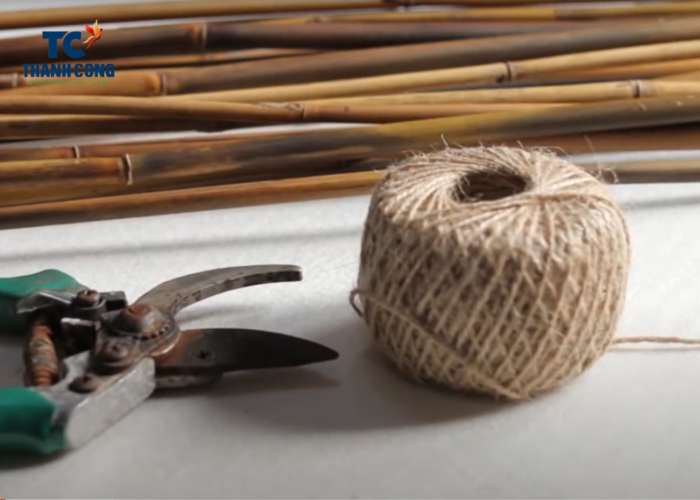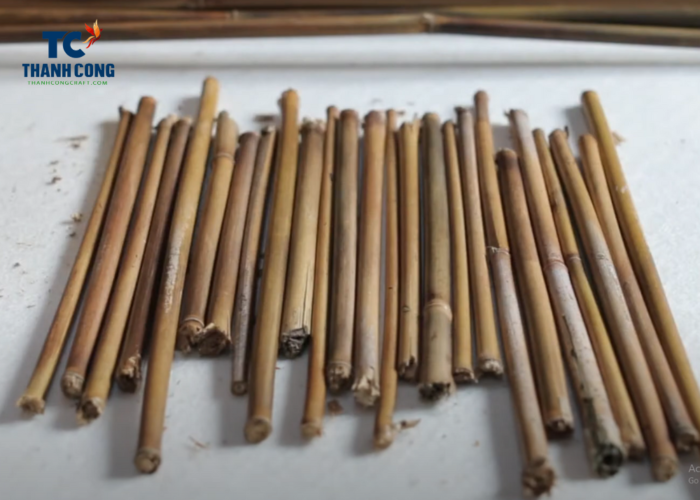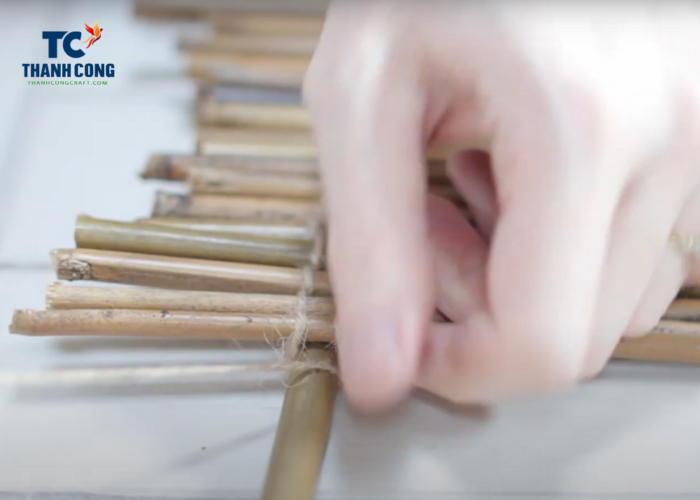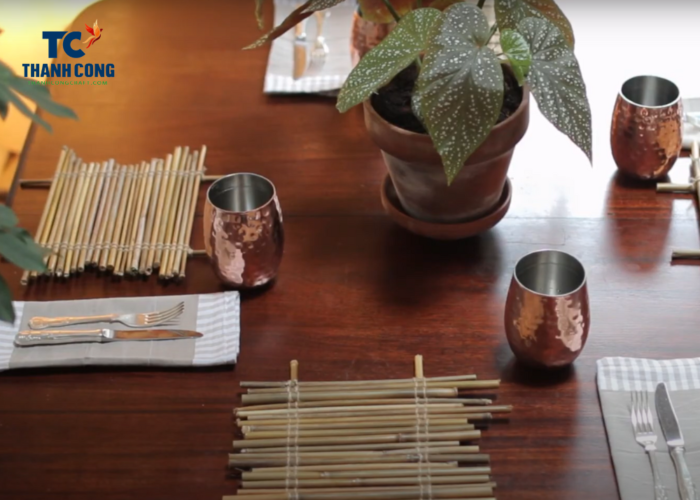The dining table serves as the heart of the home, a place where family gathers to enjoy delicious meals and share captivating stories. If you’re aiming to craft a cozy and visually appealing dining space, consider creating your own table mats using bamboo – a readily available and environmentally friendly material.
This article will provide how to make bamboo placemats simple yet effective bamboo table mats, adding a touch of personalization to your dining experience.
Contents
1. How to make bamboo placemats?
A bamboo tablecloth is a simple but useful item in the family. They not only help protect the dining table from scratches, heat or mold, but also create a cozy and friendly space. To make a bamboo tablecloth, you need to prepare the following materials and tools:
- Bamboo: You can buy pre-treated bamboo or choose and process fresh bamboo. If using fresh bamboo, you need to wash, cut off the bamboo eyes, polish and dry the bamboo until it has a pale yellow color.
- Rope: You can use natural ropes such as cotton, linen, jute or coconut fiber. The rope must be durable and not shrink when exposed to water.
- Scissors, knife, ruler, pencil: To cut and measure bamboo according to the desired size.
- Drill, nail, hammer: To drill holes and fix bamboo together.

After having all the materials and tools, you can follow these steps to make a bamboo tablecloth:
Step 1
The first step to make bamboo table mats/ placemats is cutting the bamboo branches into small strips with a width of about 1-2 cm and a length depending on the size of the tablecloth you want to make. You should cut the bamboo so that the strips have a uniform thickness and are not cracked.
Ensuring a uniform thickness and preventing cracks in the bamboo strips is emphasized to guarantee both structural integrity and aesthetic appeal in the finished product, making the overall process of crafting the tablecloth more manageable.

Step 2
Drill holes at both ends of each bamboo strip, about 0.5 cm from the edge. The drill hole should have a smaller diameter than the rope so that the rope can pass through but not loose.
This step facilitates the preparation of the bamboo strips for the subsequent assembly process, where they will be interlinked by the rope, contributing to the overall strength and cohesion of the tablecloth.
Step 3
Arrange the bamboo strips parallel to each other along the width of the tablecloth. Then, use the rope to tie the bamboo strips together along the length of the tablecloth. You should tie the rope on both sides of each drill hole to increase the stability of the tablecloth.
You should also align the bamboo strips so that the distance between them is equal.

Step 4
To complete the tablecloth, you can use a knife to cut off any excess parts of the bamboo or rope. You can also paint or decorate the tablecloth as you like. This final stage not only ensures the functionality and durability of the tablecloth but also provides a creative outlet for individual expression in terms of design and aesthetics.

2. FAQs
2.1 Are bamboo placemats washable? Are bamboo placemats easy to clean?
Yes, bamboo placemats are generally washable and easy to clean. However, the specific care instructions may vary depending on the manufacturer and the type of finish applied to the bamboo.
In most cases:
- Handwashing: It is often recommended to handwash bamboo placemats with mild soap and warm water. Avoid using harsh chemicals or abrasive scrubbers that could damage the bamboo.
- Drying: After washing, it’s advisable to let the placemats air dry. Excessive moisture can potentially lead to mold or warping, so it’s essential to ensure they are thoroughly dried before storing or using them again.
- Avoiding Dishwashers: While some bamboo placemats may be labeled as dishwasher-safe, it’s generally safer to avoid using dishwashers, as the high water pressure and heat can be harsh on bamboo, leading to deterioration over time.
Always refer to the care instructions provided by the manufacturer to ensure the longevity and optimal performance of your bamboo placemats.
2.2 Can bamboo mats go in the dishwasher?
While some bamboo products may be labeled as dishwasher-safe, it’s essential to check the specific care instructions provided by the manufacturer for your bamboo mats. In general, it’s advisable to avoid putting bamboo mats in the dishwasher unless explicitly stated otherwise by the manufacturer.
Dishwashers can expose bamboo to high water pressure and elevated temperatures, which may lead to warping, cracking, or other forms of damage. Handwashing with mild soap and warm water is a safer method for cleaning bamboo mats.
After washing, it’s recommended to air dry them thoroughly before using or storing to prevent issues like mold or deterioration.
Always follow the care guidelines provided by the manufacturer to ensure the longevity and optimal performance of your bamboo mats.
2.3 Can you paint bamboo placemats?
Yes, you can paint bamboo placemats. Bamboo is a versatile material that can be customized and decorated to suit your preferences. If you choose to paint bamboo placemats, here are some general steps to follow:
- Clean the Surface: Ensure that the bamboo placemats are clean and free from any dirt or debris. You can wipe them down with a damp cloth and allow them to dry completely.
- Sand the Surface (Optional): If the bamboo has a glossy finish or if you want to improve paint adhesion, you can lightly sand the surface with fine-grit sandpaper.
- Use Acrylic Paints: Acrylic paints are a suitable choice for painting bamboo. They adhere well to the surface and come in a wide range of colors. Ensure that the paint you choose is suitable for wood surfaces.
- Apply Primer (Optional): If you’re working with untreated bamboo or want to ensure better paint adhesion, you can apply a primer before painting.
- Painting: Use a brush or sponge to apply the paint evenly across the bamboo surface. Allow each coat to dry before applying the next one. Multiple thin coats are generally more effective than one thick coat.
- Sealing (Optional): Once the paint is dry, you may choose to seal the painted bamboo with a clear varnish or sealer. This step helps protect the paint and provides a more durable finish.
Remember to follow the specific recommendations of the paint and sealant products you choose, and let the placemats dry completely before using them. Painting bamboo placemats allows you to add a personal touch and match them to your decor.
In conclusion, creating your own bamboo placemats can be a rewarding and personalized endeavor. By following the steps outlined in this guide on “how to make bamboo placemats” you have the opportunity to craft functional and aesthetically pleasing table settings.
For any questions, please send thanhcongcraft an email us at info@thanhcongcraft.com or message us at WhatsApp: +84967485411. Our team are always willing to assist you!












